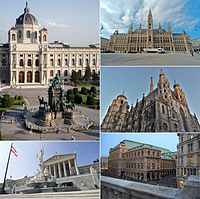
Photo from wikipedia
Abstract For the investigation of intra-urban air temperature patterns, high spatial resolution observations are needed. To reach such a dense monitoring network in a cost-efficient way, recently there have been… Click to show full abstract
Abstract For the investigation of intra-urban air temperature patterns, high spatial resolution observations are needed. To reach such a dense monitoring network in a cost-efficient way, recently there have been efforts to utilize networks of citizen weather stations (CWS). Here, quality-controlled crowd-sourced CWS air temperature observations were used to study the temperature distribution in Vienna, Austrian, for an 11-day high-temperature period in August 2018. The statistical quality control was based on the procedure developed in a previous study, further optimized by incorporating two additional steps addressing the specific issue of radiative errors using solar radiation data from non-CWS reference stations. After application of the quality control, CWS air temperature data provide results comparable to stations of the national meteorological service network, and discrepancies between these data sets could be explained by differences in station location relative to the urban structure. In Vienna, 1357 unique stations were available during the study period, of which 1083 stations passed the full quality control procedure. Compared to the currently available operational network, this represents a major improvement in the spatial resolution of available temperature data. Hence, quality-controlled CWS data for Vienna seem a promising data source for further urban climate studies of the area.
Journal Title: urban climate
Year Published: 2020
Link to full text (if available)
Share on Social Media: Sign Up to like & get
recommendations!